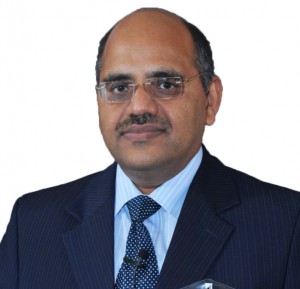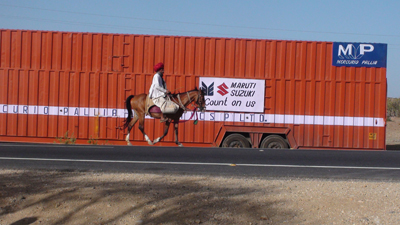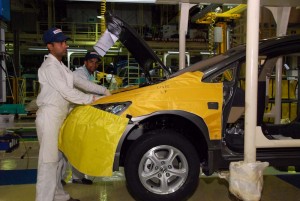 Achal Paliwal (left), until recently head of exports and logistics at Honda Cars India, sat down for a pint or two with our India correspondent to discuss a career in vehicle logistics and the evolution of two Japanese companies in India with very different approaches.
Achal Paliwal (left), until recently head of exports and logistics at Honda Cars India, sat down for a pint or two with our India correspondent to discuss a career in vehicle logistics and the evolution of two Japanese companies in India with very different approaches.
When long-serving executives step down from their role, they often prefer to remain tight-lipped about their tenure and the companies for which they worked. But 48-year-old Achal Paliwal, who recently left Honda Cars India as head of exports and sales logistics after nine years, and 28 in the automotive sector, is different. One hot June afternoon in Delhi, less than 150km from Gurgaon, where he started his career in 1986 with Maruti Suzuki (then Maruti Udyog), Paliwal met with Automotive Logistics’ Ramesh Kumar to walk down memory lane over several pints of cold draught beer. He revealed the impressive journey that both of these carmakers have made in their vehicle logistics processes and customer focus over this time.
With a career spanning the modern Indian automotive sector, Paliwal is in a unique position to reflect on the outbound sector’s evolution in India. Educated and trained as a mechanical engineer, working the first decade of his career in precision parts, Paliwal helped to implement new designs and standards for India’s car transporters while at Maruti, a difficult transformation that helped lower damage rates from an abysmal 14% to a very respectable 1.8% by the time he left the company in 2005.
Later, he would help Honda update its own logistics processes to better serve India’s demanding consumers. If Maruti’s logistics were racing cars through the system as fast as possible, Honda’s were about stringent quality checks. Over time, Paliwal helped develop a middle ground, allowing Honda to compete with other OEMs on lead times even as it became a benchmark for quality.
Paliwal has not yet confirmed his next position. However, he says that his heart “has always been in logistics”, and after nearly three decades, he seems unwilling to let the industry go just yet.
Ramesh Kumar: Tell me about your journey to vehicle logistics at Maruti?
Achal Paliwal: I started at Maruti Udyog as a trainee engineer in the manufacturing division. Over the next nine years I went through production, production planning and for a brief period the material services function. In mid-1995 I had an opportunity to learn more about the Japanese language, culture, business practices and shop floor management practices – known as Genba Kaanri – for four months at the Kansai Kenshu Center (KKC) in Osaka and thereafter at Suzuki headquarters at Hamamatsu. This happened with funding from the AOTS (Association for Overseas Technical Scholarship). During that trip, I learnt a variety of practices at the shop floor, for material services and robotic programming at Suzuki subsidiary plants. On return, I decided to jump into a pool of challenges with finished vehicle logistics in the marketing division.
What brought about this change to logistics?
Switching to logistics was driven primarily by my urge to come out of my comfort zone. Computerised precision machining was my specialisation and I wanted to explore new avenues and challenges for my own professional satisfaction. However, a transfer to the marketing division was always in my mind due to my extroverted nature and the vast opportunity I anticipated there.
Still, I never dreamt that I would land in finished vehicle logistics. This arena fascinated me primarily because as a mechanical engineer I could play a more significant role in reducing transit damages, which was a major challenge at that time for Maruti.
You haven spoken about 14% transit damages. Can you elaborate?
That I would discover later. I first learnt about transit damage as an issue from other trainees while in Japan, and I came back with this on my mind. But when the top Maruti management said that damage was a major challenge from a financial and customer viewpoint, I never realised how big an issue it was. So when I landed up in sales and dispatch (S&D), life was full of challenges. Yes, damages were as high as 14% at that time. And to make the matters worse, the majority of the damages were of a very serious nature: damage to the roof or body shell where we had no option but to scrap the body shell. This was a very costly affair because Maruti was practicing a self-insurance pool mechanism to compensate for such damages, which meant that the losses were always borne by Maruti itself. Then there was also the delivery delays and customer dissatisfaction.
Did the management try to figure out why the cars had so much damage?
I am sure they figured it out to some extent because there were many wiser people before me in the department. But the main solution at the time was probably pruning the trees. You will wonder about this. Well, after the rainy season every year, a bunch of trainees, engineers and helpers rode on a truck from the Gurgaon factory to the Gurgaon railway siding about 10km away to cut the overhanging tree branches, which were potential hazards to cars on the top deck. This was the route for export vehicles being sent from factory to Jawaharlal Nehru Port Trust [in Mumbai] by rail. These vehicles were found to be in non-dispatchable condition on reaching ports. That was my first lesson of transit risk mitigation, in around 1996.
Weren’t the cars delivered in covered trailers?
The car carriers of 1990s were very close relatives to European equipment, with open roofs or topless. Cars in the top deck – especially higher ones like Omni and Gypsy models – were hit the most. Those damaged vehicles contributed to huge losses because Maruti had to compensate dealers, while those damaged cars were to come back to the factory for repair and body shell change.
Resolving this problem was not easy since this required lot of investment and, more than that, a mindset change. However, we introduced some changes and by the time I left Maruti, the damages had dropped to 1.8%.
Did you find resistance to making change and, If so, was it from your colleagues or from carriers?

How many transport companies was Maruti dealing with at that time?
There were between 137-142 transport companies at that point of time and we were dealing with around 6,000-7000 car carrier trucks. It was very fragmented and ownership was typically 20-40 carriers per transport company.
What was your winning strategy?
In Hindi it is called Saam, Daam, Dand, Bhed, which are the four ways of persuading someone to do a task. It meant sometimes punishing them [and] sometimes creating a competitive situation where others would have an advantage if they would follow all those practices.
For the equipment, it was a long journey from the first generation carriers we started with, which had open roofs, were chain-pulley operated and secured cars by jute or plastic ropes, to the multi-axle carriers we use today, which are hydraulically operated and secure cars with wheel belts. It was a long, very painful and eventful journey from 14% damage to 1.8%. But it was the end result of the collective efforts of not only my own team but also transporters to improve and re-invent the car carrier hardware, storage, handling processes and, more importantly, their own ways of managing logistics. The contribution of Toyota Kirloskar in later years was also immense in improving hardware quality and vehicle handling processes of the Indian automotive landscape, which they brought along with their logistics partner, Transystem Logistics [a joint venture between Japan’s Mitsui and India’s TCI].
What was your last job at Maruti?
I was deputy manager handling the transport management section and thereafter had a very special project when I left Maruti. I was working on a huge excise duty refund from the central excise department. It was almost an impossible task, because some claims were seven or eight years old and there was lot of litigation over them.
By working so much in vehicle logistics, has it meant that you haven’t put much of your education to use?
No, because for nine years before switching to S&D I made 100% use of my mechanical engineering skills. We were responsible for producing very high precision components at a very high rate of production. It was a pure engineering job but I realised that there is more than engineering in life. However, engineering never left me and I applied these skills while improving hardware and carrying on innovation for vehicle logistics that would lead to damage reduction and efficiency improvements.

My main learning was about its philosophy of being fast, flexible and the first mover; that is the secret behind its continued and undisputed market leadership. The top management had a very clear vision and was very customer-focused, with futuristic thinking in particular around how to give a differentiated product to the customer as well as forecasting customer preference, especially in small cars. More importantly the decision making process at Maruti was very fast – I would say lightning fast.
Apart from that, it has a policy of periodic management rotation within and across divisions, which provided much needed fresh air and sunshine for professional growth. I feel fortunate to have grown as a logistic professional under such policies. Otherwise, I would have never thought of transferring from manufacturing to the marketing division and to finished vehicle logistics.
How difficult was it for you to move from Maruti to Honda?
It was a very difficult decision – like butterflies in the stomach. I had never thought of changing from Maruti to any other company primarily because initially Maruti was a kind of government joint venture; it was practically a public sector organisation and we never felt a need for change, even after Suzuki took a majority control. However by March 2005 I had completed my MBA at MDI in Gurgaon. During those studies I realised that many people were changing jobs every three years or five years religiously. Why not me?
In what capacity did you join Honda?
On October 26th 2005 I joined Honda’s commercial department as a level one manager. I discovered after joining that I was hired primarily for development of a dealer distribution management system. That was never discussed with me during the interview sessions, unfortunately. However, my heart and soul always remained in logistics and I would not miss any opportunity to get involved wherever possible. My acquaintance with our logistics service providers made it even more compelling for me because whenever they visited Honda they would ask for me, which gave me the opportunity to barge in. In the process, I earned the displeasure of one of my senior colleagues for infringement on his exclusive territory and I was reprimanded within 15 days of joining. Soon, however, my seniors realised that my core competency lies in logistics management, and I was formally entrusted with the outbound logistics function.
How different were Honda’s logistics set up and practices vis-à-vis Maruti?
There was a huge gap. Honda was at a nascent stage in India when I joined. At the office, I requested my team to brief me on what they were doing. For two days nobody turned up. I followed it up further with the gentleman in-charge of the site office for the logistics department. He told me that everyone was very tense and busy because they were preparing to dispatch 120 cars per day.
That was a shock since I came from an environment where we were dispatching 1,700-2,600 cars per day – almost 30 times the volume these guys were talking about. Then I learned that Honda’s processes were so elaborate with multiple checks, and a quality obsession so high that each process was taking thrice the time it would have taken otherwise. I realised that if Honda were to grow, it would need to re-engineer its processes.
 Honda's dispatch system was much more time-consuming than it was for Maruti, and needed to be adjusted
Honda's dispatch system was much more time-consuming than it was for Maruti, and needed to be adjustedHow similar and different did you find vehicle logistics at these two companies?
I noticed straight away that both were very clear about two priorities for logistics. First were their customer-centric approaches for end users and dealers. And secondly I would say that both companies, surprisingly, have realised the importance of finished vehicle logistics capability as a strategic enabler and not merely as a cost centre.
But Honda and Maruti have totally different DNA. At Maruti, there is a prominent and visible aggression in taking huge challenges and doing something very innovative to suit customer needs and meet the market demand. I found Maruti to be a company which believed that if you grow the business, the profit will follow.
"At Honda, the customer expectations were much higher than what I experienced at Maruti. For example, at Honda the rates of 98.2% for quality delivery and 78% on-time delivery were just not good enough – rather they were below average performance"
- Achal Paliwal, Honda Cars India
Honda had more of a philosophy that claimed if you give a good product to the customer, word of mouth will ensure the demand and then the demand itself will ensure the profit because you are in a premium segment market. This was the fundamental difference between these companies. And since Honda is a global giant, with a large business also in Europe and America, its experts were generally more refined and travelled, experienced and comfortable with the English language most importantly. So that was also a considerable difference.
However, at Maruti the level of autonomy to the local management was much higher as compared to Honda. Honda later realised that it needed to be aggressive and opened up its gates more [to Indian managers]. I think, like Maruti, it has decided to follow the leadership trait. Today Honda undoubtedly aspires to be the leader in the small car market as well.
![FRONT_3-4_TOP_SHOT_HIRES_FINAL_V6-[SILVER-RELIGHT] FRONT_3-4_TOP_SHOT_HIRES_FINAL_V6-[SILVER-RELIGHT]](https://d2hkn54fqqmadw.cloudfront.net/web/AL/wp-content/uploads/2014/08/FRONT_3-4_TOP_SHOT_HIRES_FINAL_V6-SILVER-RELIGHT-300x181.jpg)
I thoroughly enjoyed all these years and each moment of my association with Japanese companies, professionally and personally. It never struck my mind from an employee perspective or associate perspective that I would have worked for a European or western company as well, but had it been true it would have no doubt added a variety of experience to my professional life. I have never regretted missing that experience and yet at some corner I would have loved it.
Are you still nursing those thoughts? Do you have plans for the future?
I am not able to comment on this right now, but will let time reveal it. But I can safely assume that I will remain in the automotive logistics landscape for times to come.

























![Global[1]](https://d3n5uof8vony13.cloudfront.net/Pictures/web/a/d/s/global1_726550.svgz)









